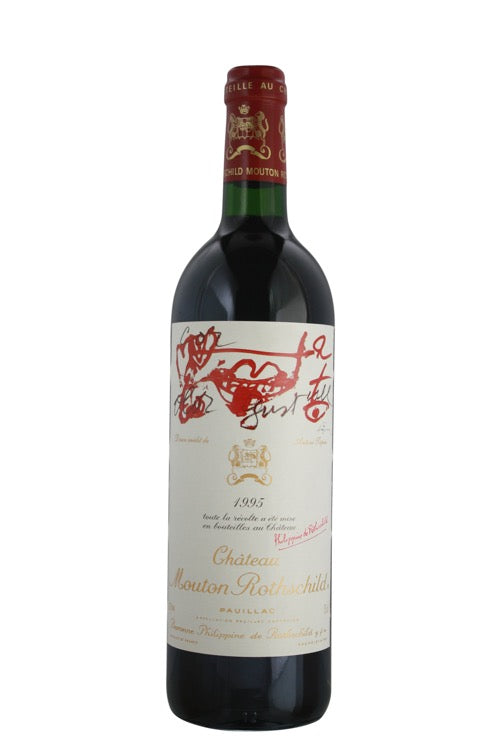1
/
of
1
Mouton Rothschild - 1995 (750ml)
Mouton Rothschild - 1995 (750ml)
Regular price
$549.99
Sale price
$549.99
Regular price
$725.99
Unit price
/
per
Bottled in June, 1997, this profound Mouton is more accessible than the more muscular 1996. A blend of 72% Cabernet Sauvignon, 9% Cabernet Franc, and 19% Merlot, it reveals an opaque purple color, and reluctant aromas of cassis, truffles, coffee, licorice, and spice. In the mouth, the wine is "great stuff," with superb density, a full-bodied personality, rich mid-palate, and a layered, profound finish that lasts for 40+ seconds. There is outstanding purity and high tannin, but my instincts suggest this wine is lower in acidity and slightly fleshier than the brawnier, bigger 1996. Both are great efforts from Mouton-Rothschild. Anticipated maturity: 2004-2030.
Robert Parker - 95 points
Robert Parker - 95 points
Availability:
3 In Stock
$25 Shipping on Orders +$299
Couldn't load pickup availability
Share :

- varietal
- Region
- Sub - Region
- Type
- Reviews
Product Review
Bottled in June, 1997, this profound Mouton is more accessible than the more muscular 1996. A blend of 72% Cabernet Sauvignon, 9% Cabernet Franc, and 19% Merlot, it reveals an opaque purple color, and reluctant aromas of cassis, truffles, coffee, licorice, and spice. In the mouth, the wine is "great stuff," with superb density, a full-bodied personality, rich mid-palate, and a layered, profound finish that lasts for 40+ seconds. There is outstanding purity and high tannin, but my instincts suggest this wine is lower in acidity and slightly fleshier than the brawnier, bigger 1996. Both are great efforts from Mouton-Rothschild. Anticipated maturity: 2004-2030.
Product Score
95
Cabernet Sauvignon is one of the most prominent dark-skinned grape varieties except Merlot in terms of area under vines, but which comprises our largest selection of wines. Grown in just about every wine producing region and climate, Cabernet Sauvignon can express a huge range of aromas, from green peppers in cool climates through to dark jammy fruit in hot regions. Common aromas include blackcurrants, mint, graphite, and forest floor, to name a few. Maturation in small oak barrels can develop a complex range of aromas from cedar wood, cigar box and tobacco to eucalyptus and undergrowth. Cabernet Sauvignon’s success is partly due to its ability to adapt to a range of soils and climates. It is the main constituent of the Bordeaux blend in the revered communes of Pauillac, St. Estephe and St. Julien, and has achieved equal success in California’s Napa Valley. It is grown extensively throughout Southern Australia, with some outstanding examples from the Terra Rossa soil of Coonawarra. Cabernet Sauvignon also plays an increasing role in Tuscany, Italy, where it is blended with native varieties such as Sangiovese to produce the Super Tuscans.
Located in South West France, Bordeaux is one of the World’s most important wine producing regions. The Gironde estuary and its two tributaries, the Garonne and Dordogne, splits the region into the ‘left bank’ and ‘right bank’. The left bank, on the west side of the Gironde, consists of the Médoc and Graves, while Pomerol and St. Emilion are located on the right bank. In between the Garonne and Dordogne is the Entre-Deaux-Mers region, French for 'between two seas'. From north to south the Médoc includes the famous classed growth chateaux in the communes of St. Estephe, Paulliac, St.Julien, and Margaux. The Graves and it’s enclave Pessac-Léognan make both red and white wine. While those of Pessac- Léognan’s are dry, Sauternes and Barsac make world-famous sweet whites. Although Bordeaux makes some of the world’s most expsenive wines, less expensive but good value alternatives come from Moulis and Listrac on the left and Bourg and Blaye on the right offer less expensive wines for earlier consumption.
Pauillac is an important commune of the Medoc on the left bank of Bordeaux's Gironde estuary. Sandwiched between St. Estephe to the north and St. Julien so the south, the village boasts three of the Medoc’s five first growths ranked in the official Classification of 1855. They include Chateau Lafite, Latour, and Mouton. It is also home to no less than 12 fifth growths, whose fierce competition has led to a increase in the standard of their wine. Consequently, at a fraction of the price, they are often considered are great deal when compared to first growths and even “super seconds”.
Red wine is wine made from dark-coloured grape varieties. The color of red differs based on the grapes variety or varieties used.Interestingly, black grapes yield a juice that is greenish-white. The actual red color comes from anthocyan pigments (also called anthocyanins) from the skin of the grape (exceptions are the relatively uncommon teinturier varieties, which produce a red colored juice). Most of the production centers around the extraction of color and flavor from the grape skin.


